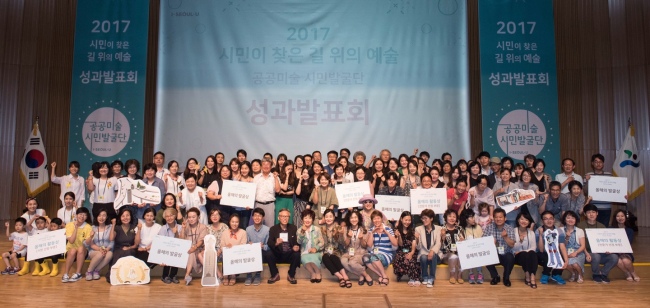Some 100 Seoul residents, art connoisseurs and city officials gathered at Seoul City Hall on Saturday to mark the completion of a two-month program to find and promote lesser-known street art and landmarks in the capital city.
Under the “Art on Seoul’s Streets Found by Citizens” project, participants, each divided into 11 group and joined by field experts, visited various parts of Seoul to discover relatively little known artworks.
Finishing the two-month project, participants said the program helped them realize the importance of the city’s public art.
Under the “Art on Seoul’s Streets Found by Citizens” project, participants, each divided into 11 group and joined by field experts, visited various parts of Seoul to discover relatively little known artworks.
Finishing the two-month project, participants said the program helped them realize the importance of the city’s public art.

During Saturday’s wrap up session, participants shared their views on what they have felt and found over the last two months.
One team, which mainly focused on finding public art that contains historical traces of Seoul, said public art helped citizens connect with how today’s Seoul came into being.
Citing examples of Yangjae-dong’s memorial park built to remember the 1995 Sampoong Department Store Collapse and Jeon Tae-il Bridge in Jongno, participants said public art allowed people to remember and find traces of Korea’s tumultuous modern history.
Another group highlighted the positive function that public art plays in citizens’ lives.
“Seoul’s installed art, some with witty message and unique structure, provide energy to passersby,” said Jung Yo-han, who said that his team discovered some 150 installed arts through the program.
Marking the competition of their mission to find and promote artistic appeal of the city, participants created a public art map indicating 73 installed art in the capital, based on each team’s top 5-10 favorite pieces.
After learning about relatively unknown artworks, participants said they developed a sense of duty to preserve them for the next generation through this program.
They suggested the city government to also actively engage in management of public art.
Rather than setting up brand new art each year, it is more necessary to keep the original pieces clean and make sure installed artworks are not neglected, they said.
Eleven curators, who each led a group of 10 to 11 citizens, also shared “sad part” about Seoul’s public art, from expert’s point of view.
Some of unappealing murals, which were indiscreetly introduced in the city when a mural town became a big hit a decade ago, are going out of trend, they said.
“We want the Seoul City to look into undiscovered public art more with thorough review so they can intrigue more citizens to enjoy,” said Gwak Na-yeon.
Seoul City welcomed the suggestion.
“Based on various opinions and suggestions made on Saturday, we will hear more voice from citizens and take them into consideration when executing the city government’s design policies,” sad Byun Seo-young, head of the Seoul Metropolitan Government’s design policy division.
By Kim Da-sol (ddd@heraldcorp.com)
-
Articles by Korea Herald








![[Graphic News] More Koreans say they plan long-distance trips this year](http://res.heraldm.com/phpwas/restmb_idxmake.php?idx=644&simg=/content/image/2024/04/17/20240417050828_0.gif&u=)
![[KH Explains] Hyundai's full hybrid edge to pay off amid slow transition to pure EVs](http://res.heraldm.com/phpwas/restmb_idxmake.php?idx=644&simg=/content/image/2024/04/18/20240418050645_0.jpg&u=20240419100350)






![[From the Scene] Monks, Buddhists hail return of remains of Buddhas](http://res.heraldm.com/phpwas/restmb_idxmake.php?idx=652&simg=/content/image/2024/04/19/20240419050617_0.jpg&u=20240419175937)

![[KH Explains] Hyundai's full hybrid edge to pay off amid slow transition to pure EVs](http://res.heraldm.com/phpwas/restmb_idxmake.php?idx=652&simg=/content/image/2024/04/18/20240418050645_0.jpg&u=20240419100350)

![[Today’s K-pop] Illit drops debut single remix](http://res.heraldm.com/phpwas/restmb_idxmake.php?idx=642&simg=/content/image/2024/04/19/20240419050612_0.jpg&u=)